Comparing Health Impacts: A Report on Cultural and Social Diversity
VerifiedAdded on 2023/06/03
|11
|2708
|193
Report
AI Summary
This report provides a comparative analysis of the health impacts on two culturally diverse communities in Australia: Aboriginal and Torres Strait Islander peoples and the Amish. It examines the historical and current events that have influenced various risk factors within each group, highlighting differences in healthcare policies, service provisions, and health-seeking behaviors. The report discusses the overreaching framework of the National Aboriginal and Torres Strait Islander Health Plan and contrasts it with the Amish community's reliance on traditional beliefs and self-funded healthcare. Ultimately, the report underscores the significant influence of cultural and historical contexts on health outcomes and advocates for culturally sensitive approaches to healthcare to improve the well-being of diverse populations. Desklib offers this and many other solved assignments for students.
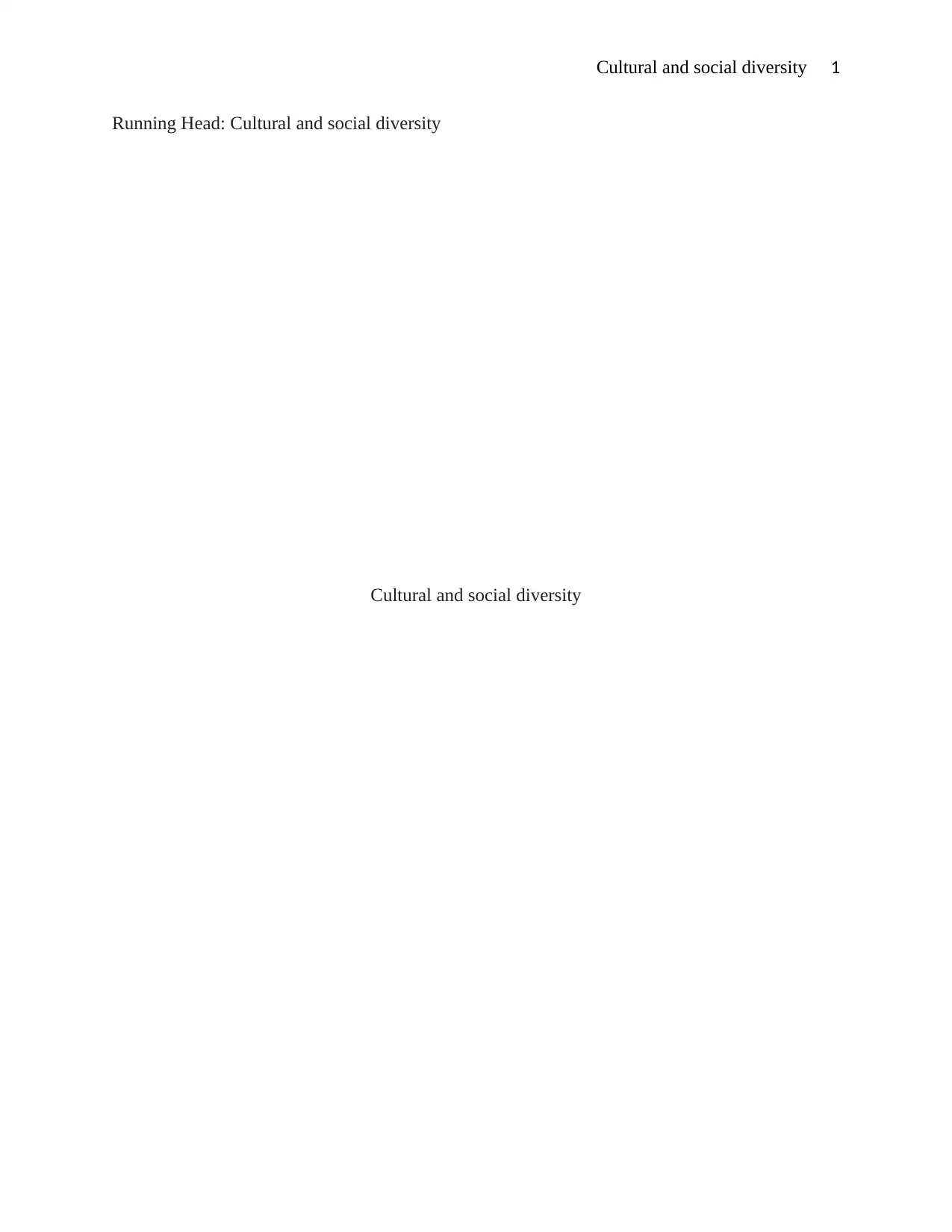
Cultural and social diversity 1
Running Head: Cultural and social diversity
Cultural and social diversity
Running Head: Cultural and social diversity
Cultural and social diversity
Paraphrase This Document
Need a fresh take? Get an instant paraphrase of this document with our AI Paraphraser
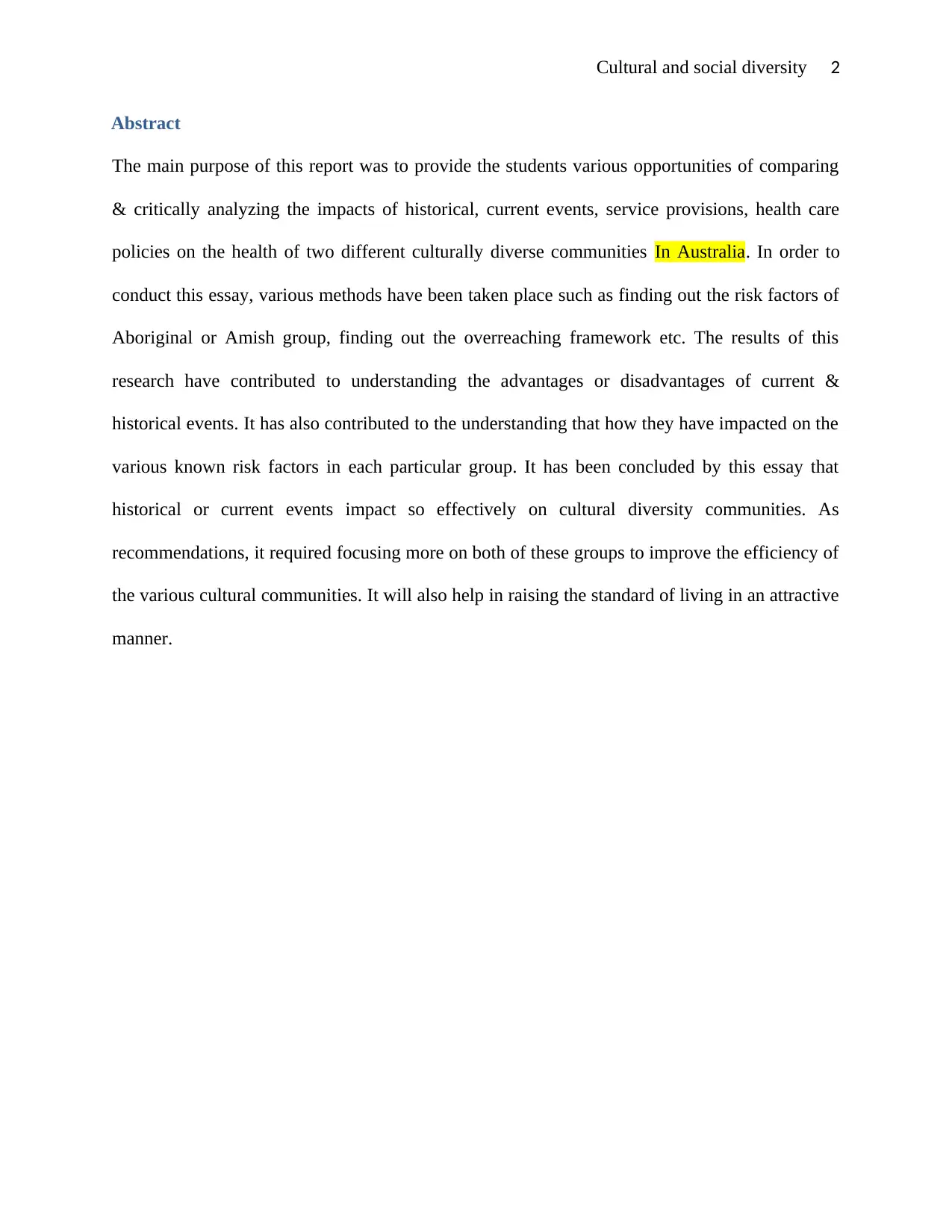
Cultural and social diversity 2
Abstract
The main purpose of this report was to provide the students various opportunities of comparing
& critically analyzing the impacts of historical, current events, service provisions, health care
policies on the health of two different culturally diverse communities In Australia. In order to
conduct this essay, various methods have been taken place such as finding out the risk factors of
Aboriginal or Amish group, finding out the overreaching framework etc. The results of this
research have contributed to understanding the advantages or disadvantages of current &
historical events. It has also contributed to the understanding that how they have impacted on the
various known risk factors in each particular group. It has been concluded by this essay that
historical or current events impact so effectively on cultural diversity communities. As
recommendations, it required focusing more on both of these groups to improve the efficiency of
the various cultural communities. It will also help in raising the standard of living in an attractive
manner.
Abstract
The main purpose of this report was to provide the students various opportunities of comparing
& critically analyzing the impacts of historical, current events, service provisions, health care
policies on the health of two different culturally diverse communities In Australia. In order to
conduct this essay, various methods have been taken place such as finding out the risk factors of
Aboriginal or Amish group, finding out the overreaching framework etc. The results of this
research have contributed to understanding the advantages or disadvantages of current &
historical events. It has also contributed to the understanding that how they have impacted on the
various known risk factors in each particular group. It has been concluded by this essay that
historical or current events impact so effectively on cultural diversity communities. As
recommendations, it required focusing more on both of these groups to improve the efficiency of
the various cultural communities. It will also help in raising the standard of living in an attractive
manner.
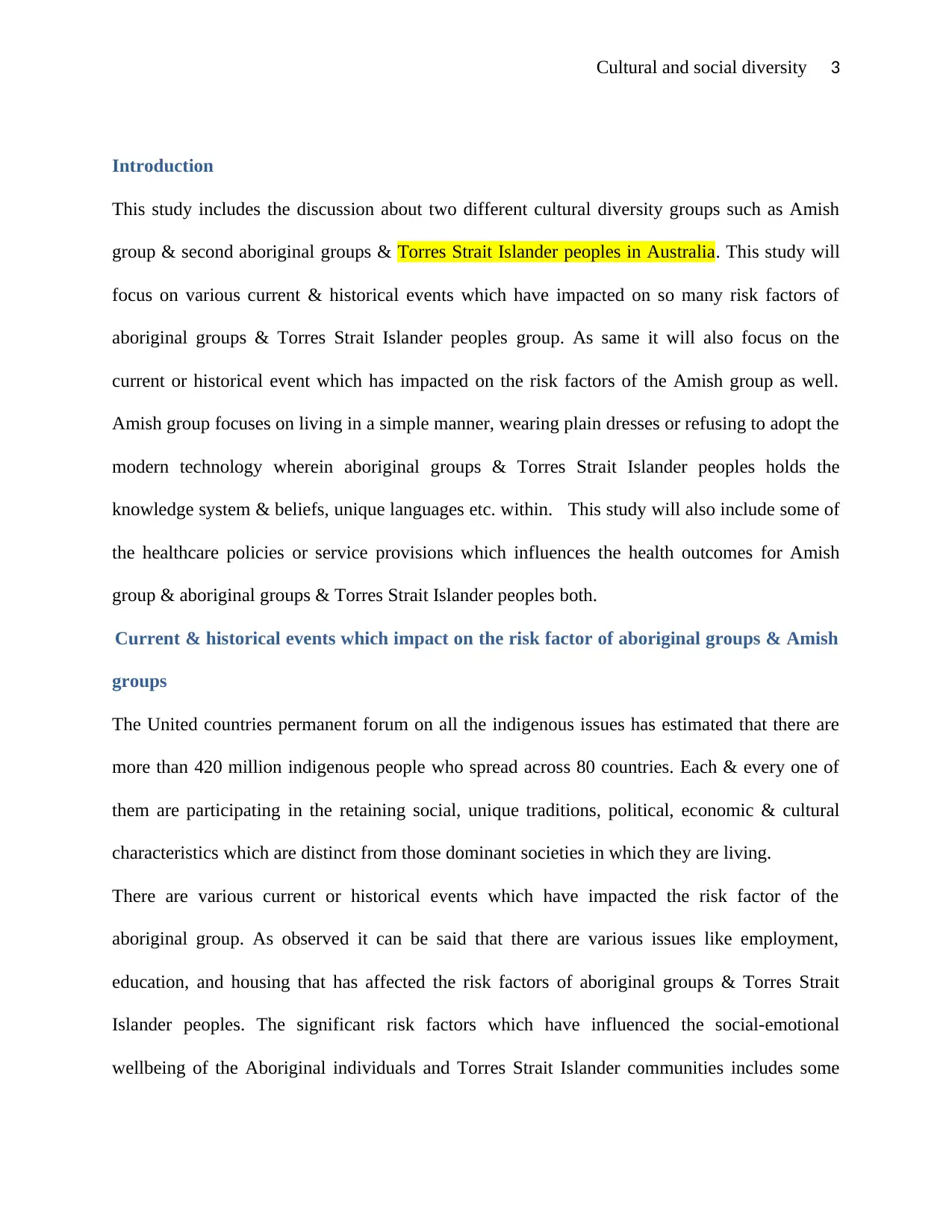
Cultural and social diversity 3
Introduction
This study includes the discussion about two different cultural diversity groups such as Amish
group & second aboriginal groups & Torres Strait Islander peoples in Australia. This study will
focus on various current & historical events which have impacted on so many risk factors of
aboriginal groups & Torres Strait Islander peoples group. As same it will also focus on the
current or historical event which has impacted on the risk factors of the Amish group as well.
Amish group focuses on living in a simple manner, wearing plain dresses or refusing to adopt the
modern technology wherein aboriginal groups & Torres Strait Islander peoples holds the
knowledge system & beliefs, unique languages etc. within. This study will also include some of
the healthcare policies or service provisions which influences the health outcomes for Amish
group & aboriginal groups & Torres Strait Islander peoples both.
Current & historical events which impact on the risk factor of aboriginal groups & Amish
groups
The United countries permanent forum on all the indigenous issues has estimated that there are
more than 420 million indigenous people who spread across 80 countries. Each & every one of
them are participating in the retaining social, unique traditions, political, economic & cultural
characteristics which are distinct from those dominant societies in which they are living.
There are various current or historical events which have impacted the risk factor of the
aboriginal group. As observed it can be said that there are various issues like employment,
education, and housing that has affected the risk factors of aboriginal groups & Torres Strait
Islander peoples. The significant risk factors which have influenced the social-emotional
wellbeing of the Aboriginal individuals and Torres Strait Islander communities includes some
Introduction
This study includes the discussion about two different cultural diversity groups such as Amish
group & second aboriginal groups & Torres Strait Islander peoples in Australia. This study will
focus on various current & historical events which have impacted on so many risk factors of
aboriginal groups & Torres Strait Islander peoples group. As same it will also focus on the
current or historical event which has impacted on the risk factors of the Amish group as well.
Amish group focuses on living in a simple manner, wearing plain dresses or refusing to adopt the
modern technology wherein aboriginal groups & Torres Strait Islander peoples holds the
knowledge system & beliefs, unique languages etc. within. This study will also include some of
the healthcare policies or service provisions which influences the health outcomes for Amish
group & aboriginal groups & Torres Strait Islander peoples both.
Current & historical events which impact on the risk factor of aboriginal groups & Amish
groups
The United countries permanent forum on all the indigenous issues has estimated that there are
more than 420 million indigenous people who spread across 80 countries. Each & every one of
them are participating in the retaining social, unique traditions, political, economic & cultural
characteristics which are distinct from those dominant societies in which they are living.
There are various current or historical events which have impacted the risk factor of the
aboriginal group. As observed it can be said that there are various issues like employment,
education, and housing that has affected the risk factors of aboriginal groups & Torres Strait
Islander peoples. The significant risk factors which have influenced the social-emotional
wellbeing of the Aboriginal individuals and Torres Strait Islander communities includes some
⊘ This is a preview!⊘
Do you want full access?
Subscribe today to unlock all pages.

Trusted by 1+ million students worldwide
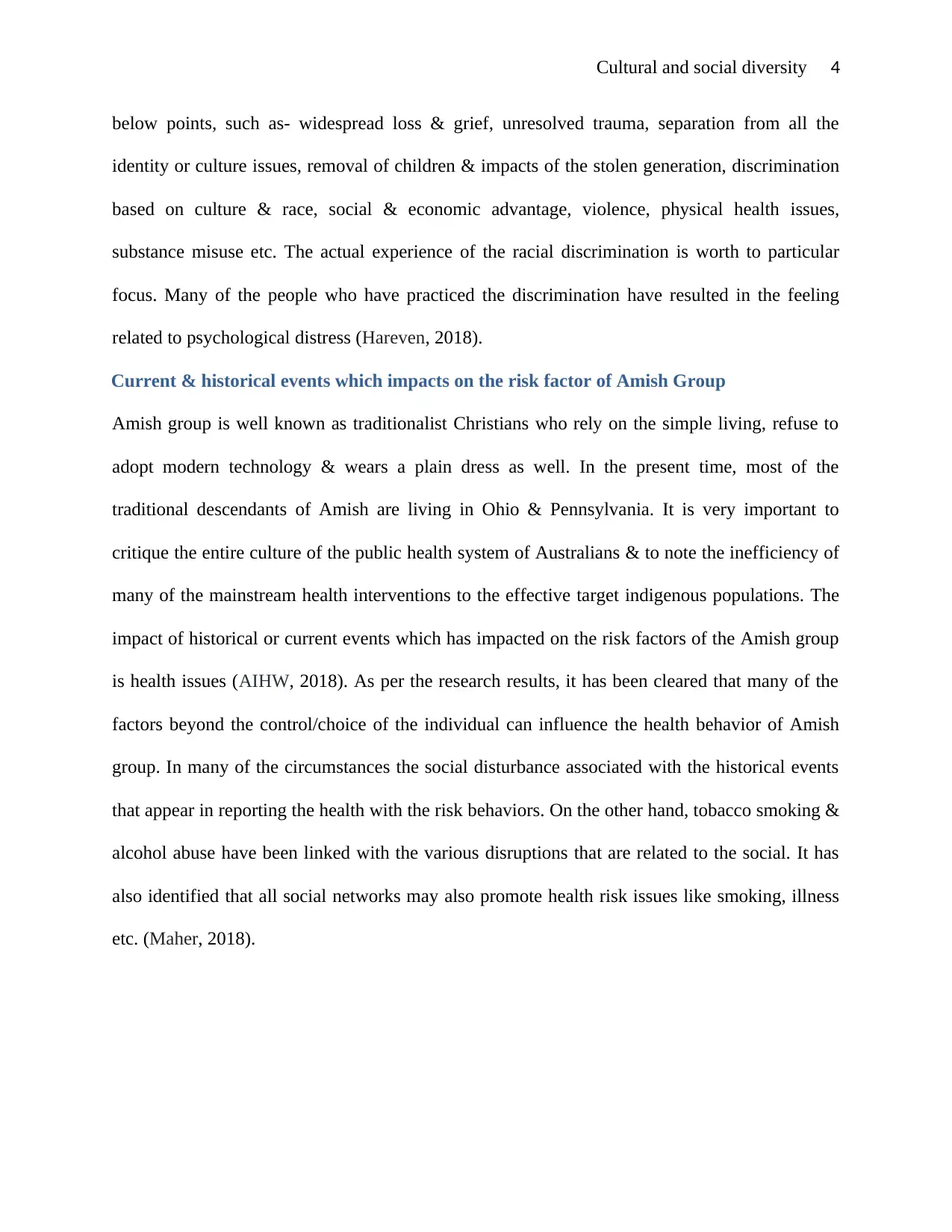
Cultural and social diversity 4
below points, such as- widespread loss & grief, unresolved trauma, separation from all the
identity or culture issues, removal of children & impacts of the stolen generation, discrimination
based on culture & race, social & economic advantage, violence, physical health issues,
substance misuse etc. The actual experience of the racial discrimination is worth to particular
focus. Many of the people who have practiced the discrimination have resulted in the feeling
related to psychological distress (Hareven, 2018).
Current & historical events which impacts on the risk factor of Amish Group
Amish group is well known as traditionalist Christians who rely on the simple living, refuse to
adopt modern technology & wears a plain dress as well. In the present time, most of the
traditional descendants of Amish are living in Ohio & Pennsylvania. It is very important to
critique the entire culture of the public health system of Australians & to note the inefficiency of
many of the mainstream health interventions to the effective target indigenous populations. The
impact of historical or current events which has impacted on the risk factors of the Amish group
is health issues (AIHW, 2018). As per the research results, it has been cleared that many of the
factors beyond the control/choice of the individual can influence the health behavior of Amish
group. In many of the circumstances the social disturbance associated with the historical events
that appear in reporting the health with the risk behaviors. On the other hand, tobacco smoking &
alcohol abuse have been linked with the various disruptions that are related to the social. It has
also identified that all social networks may also promote health risk issues like smoking, illness
etc. (Maher, 2018).
below points, such as- widespread loss & grief, unresolved trauma, separation from all the
identity or culture issues, removal of children & impacts of the stolen generation, discrimination
based on culture & race, social & economic advantage, violence, physical health issues,
substance misuse etc. The actual experience of the racial discrimination is worth to particular
focus. Many of the people who have practiced the discrimination have resulted in the feeling
related to psychological distress (Hareven, 2018).
Current & historical events which impacts on the risk factor of Amish Group
Amish group is well known as traditionalist Christians who rely on the simple living, refuse to
adopt modern technology & wears a plain dress as well. In the present time, most of the
traditional descendants of Amish are living in Ohio & Pennsylvania. It is very important to
critique the entire culture of the public health system of Australians & to note the inefficiency of
many of the mainstream health interventions to the effective target indigenous populations. The
impact of historical or current events which has impacted on the risk factors of the Amish group
is health issues (AIHW, 2018). As per the research results, it has been cleared that many of the
factors beyond the control/choice of the individual can influence the health behavior of Amish
group. In many of the circumstances the social disturbance associated with the historical events
that appear in reporting the health with the risk behaviors. On the other hand, tobacco smoking &
alcohol abuse have been linked with the various disruptions that are related to the social. It has
also identified that all social networks may also promote health risk issues like smoking, illness
etc. (Maher, 2018).
Paraphrase This Document
Need a fresh take? Get an instant paraphrase of this document with our AI Paraphraser
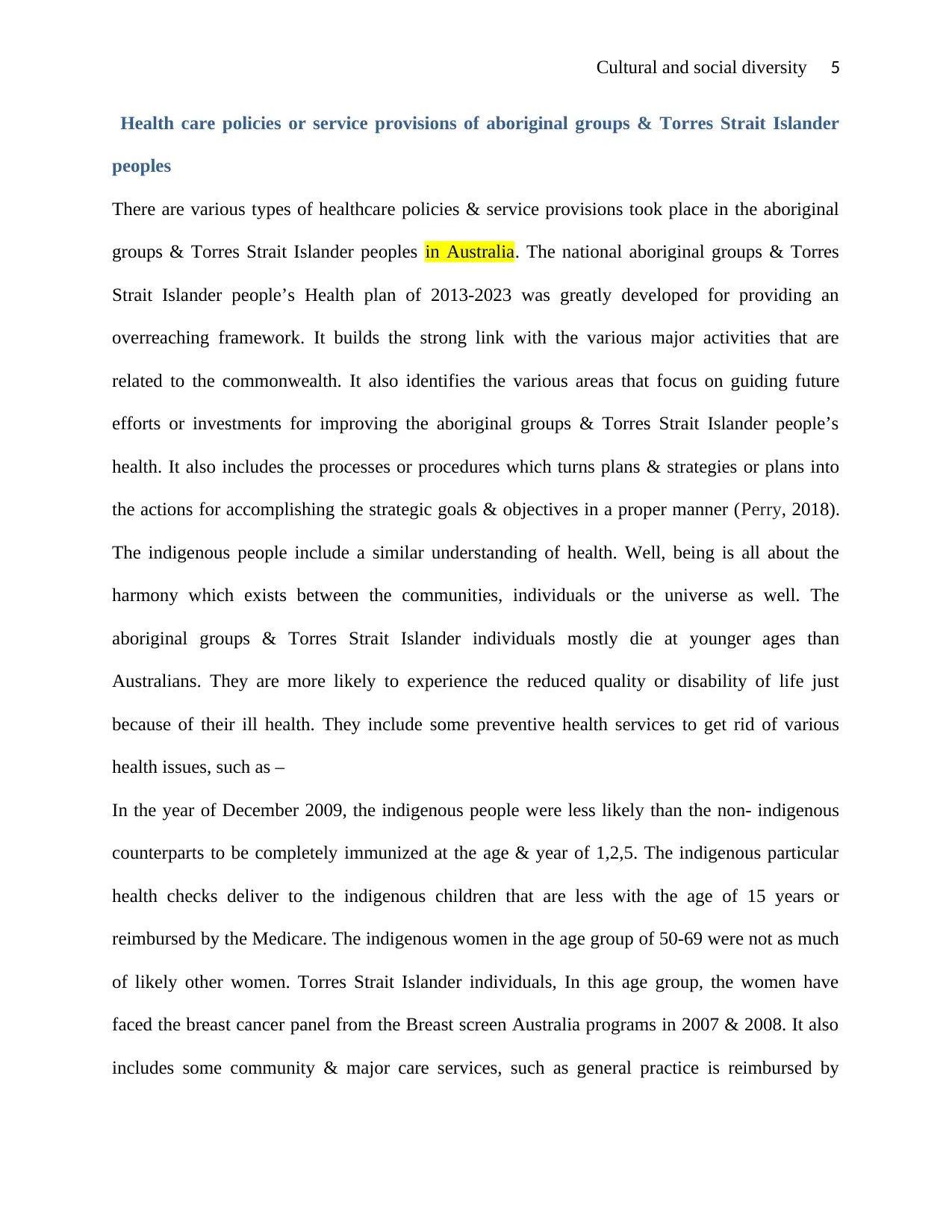
Cultural and social diversity 5
Health care policies or service provisions of aboriginal groups & Torres Strait Islander
peoples
There are various types of healthcare policies & service provisions took place in the aboriginal
groups & Torres Strait Islander peoples in Australia. The national aboriginal groups & Torres
Strait Islander people’s Health plan of 2013-2023 was greatly developed for providing an
overreaching framework. It builds the strong link with the various major activities that are
related to the commonwealth. It also identifies the various areas that focus on guiding future
efforts or investments for improving the aboriginal groups & Torres Strait Islander people’s
health. It also includes the processes or procedures which turns plans & strategies or plans into
the actions for accomplishing the strategic goals & objectives in a proper manner (Perry, 2018).
The indigenous people include a similar understanding of health. Well, being is all about the
harmony which exists between the communities, individuals or the universe as well. The
aboriginal groups & Torres Strait Islander individuals mostly die at younger ages than
Australians. They are more likely to experience the reduced quality or disability of life just
because of their ill health. They include some preventive health services to get rid of various
health issues, such as –
In the year of December 2009, the indigenous people were less likely than the non- indigenous
counterparts to be completely immunized at the age & year of 1,2,5. The indigenous particular
health checks deliver to the indigenous children that are less with the age of 15 years or
reimbursed by the Medicare. The indigenous women in the age group of 50-69 were not as much
of likely other women. Torres Strait Islander individuals, In this age group, the women have
faced the breast cancer panel from the Breast screen Australia programs in 2007 & 2008. It also
includes some community & major care services, such as general practice is reimbursed by
Health care policies or service provisions of aboriginal groups & Torres Strait Islander
peoples
There are various types of healthcare policies & service provisions took place in the aboriginal
groups & Torres Strait Islander peoples in Australia. The national aboriginal groups & Torres
Strait Islander people’s Health plan of 2013-2023 was greatly developed for providing an
overreaching framework. It builds the strong link with the various major activities that are
related to the commonwealth. It also identifies the various areas that focus on guiding future
efforts or investments for improving the aboriginal groups & Torres Strait Islander people’s
health. It also includes the processes or procedures which turns plans & strategies or plans into
the actions for accomplishing the strategic goals & objectives in a proper manner (Perry, 2018).
The indigenous people include a similar understanding of health. Well, being is all about the
harmony which exists between the communities, individuals or the universe as well. The
aboriginal groups & Torres Strait Islander individuals mostly die at younger ages than
Australians. They are more likely to experience the reduced quality or disability of life just
because of their ill health. They include some preventive health services to get rid of various
health issues, such as –
In the year of December 2009, the indigenous people were less likely than the non- indigenous
counterparts to be completely immunized at the age & year of 1,2,5. The indigenous particular
health checks deliver to the indigenous children that are less with the age of 15 years or
reimbursed by the Medicare. The indigenous women in the age group of 50-69 were not as much
of likely other women. Torres Strait Islander individuals, In this age group, the women have
faced the breast cancer panel from the Breast screen Australia programs in 2007 & 2008. It also
includes some community & major care services, such as general practice is reimbursed by
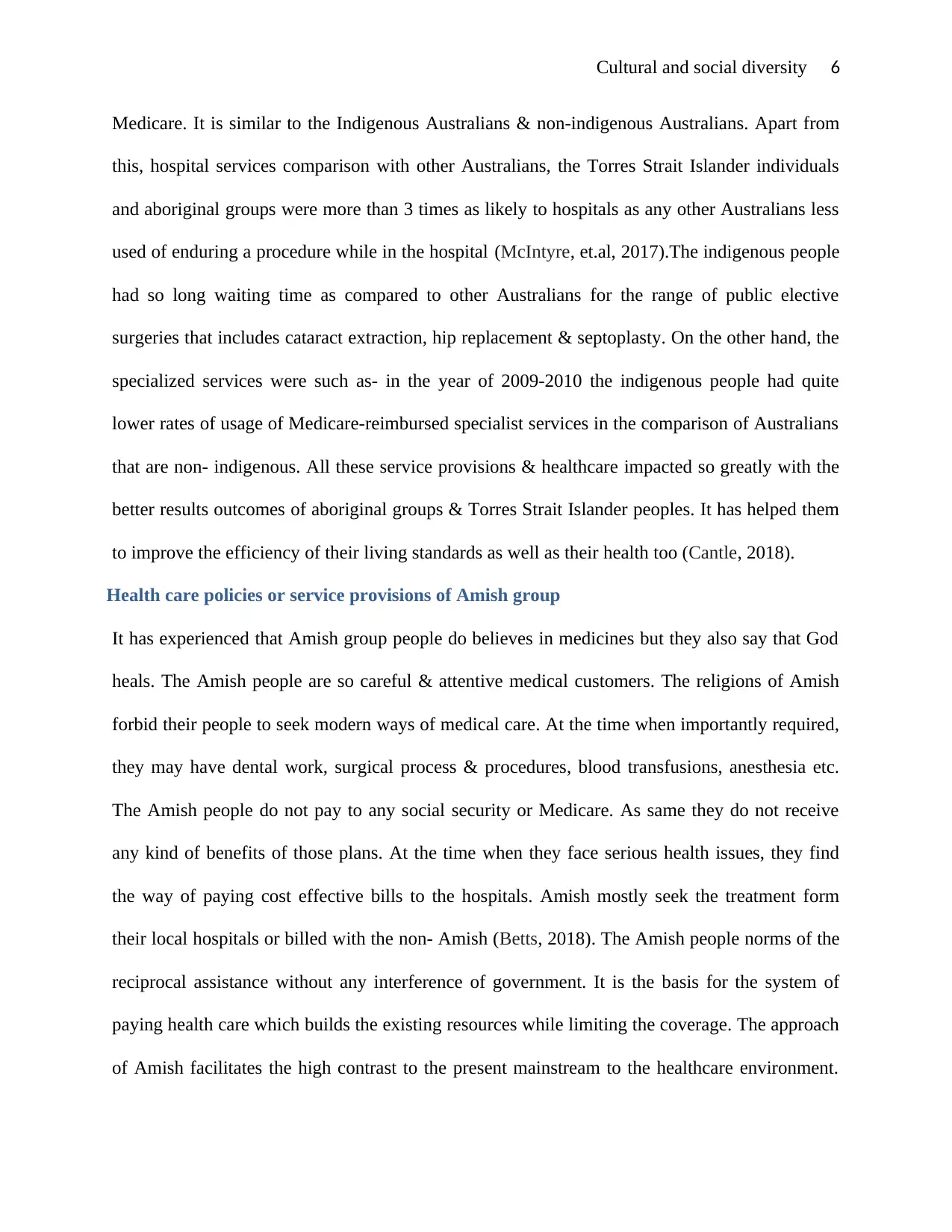
Cultural and social diversity 6
Medicare. It is similar to the Indigenous Australians & non-indigenous Australians. Apart from
this, hospital services comparison with other Australians, the Torres Strait Islander individuals
and aboriginal groups were more than 3 times as likely to hospitals as any other Australians less
used of enduring a procedure while in the hospital (McIntyre, et.al, 2017).The indigenous people
had so long waiting time as compared to other Australians for the range of public elective
surgeries that includes cataract extraction, hip replacement & septoplasty. On the other hand, the
specialized services were such as- in the year of 2009-2010 the indigenous people had quite
lower rates of usage of Medicare-reimbursed specialist services in the comparison of Australians
that are non- indigenous. All these service provisions & healthcare impacted so greatly with the
better results outcomes of aboriginal groups & Torres Strait Islander peoples. It has helped them
to improve the efficiency of their living standards as well as their health too (Cantle, 2018).
Health care policies or service provisions of Amish group
It has experienced that Amish group people do believes in medicines but they also say that God
heals. The Amish people are so careful & attentive medical customers. The religions of Amish
forbid their people to seek modern ways of medical care. At the time when importantly required,
they may have dental work, surgical process & procedures, blood transfusions, anesthesia etc.
The Amish people do not pay to any social security or Medicare. As same they do not receive
any kind of benefits of those plans. At the time when they face serious health issues, they find
the way of paying cost effective bills to the hospitals. Amish mostly seek the treatment form
their local hospitals or billed with the non- Amish (Betts, 2018). The Amish people norms of the
reciprocal assistance without any interference of government. It is the basis for the system of
paying health care which builds the existing resources while limiting the coverage. The approach
of Amish facilitates the high contrast to the present mainstream to the healthcare environment.
Medicare. It is similar to the Indigenous Australians & non-indigenous Australians. Apart from
this, hospital services comparison with other Australians, the Torres Strait Islander individuals
and aboriginal groups were more than 3 times as likely to hospitals as any other Australians less
used of enduring a procedure while in the hospital (McIntyre, et.al, 2017).The indigenous people
had so long waiting time as compared to other Australians for the range of public elective
surgeries that includes cataract extraction, hip replacement & septoplasty. On the other hand, the
specialized services were such as- in the year of 2009-2010 the indigenous people had quite
lower rates of usage of Medicare-reimbursed specialist services in the comparison of Australians
that are non- indigenous. All these service provisions & healthcare impacted so greatly with the
better results outcomes of aboriginal groups & Torres Strait Islander peoples. It has helped them
to improve the efficiency of their living standards as well as their health too (Cantle, 2018).
Health care policies or service provisions of Amish group
It has experienced that Amish group people do believes in medicines but they also say that God
heals. The Amish people are so careful & attentive medical customers. The religions of Amish
forbid their people to seek modern ways of medical care. At the time when importantly required,
they may have dental work, surgical process & procedures, blood transfusions, anesthesia etc.
The Amish people do not pay to any social security or Medicare. As same they do not receive
any kind of benefits of those plans. At the time when they face serious health issues, they find
the way of paying cost effective bills to the hospitals. Amish mostly seek the treatment form
their local hospitals or billed with the non- Amish (Betts, 2018). The Amish people norms of the
reciprocal assistance without any interference of government. It is the basis for the system of
paying health care which builds the existing resources while limiting the coverage. The approach
of Amish facilitates the high contrast to the present mainstream to the healthcare environment.
⊘ This is a preview!⊘
Do you want full access?
Subscribe today to unlock all pages.

Trusted by 1+ million students worldwide
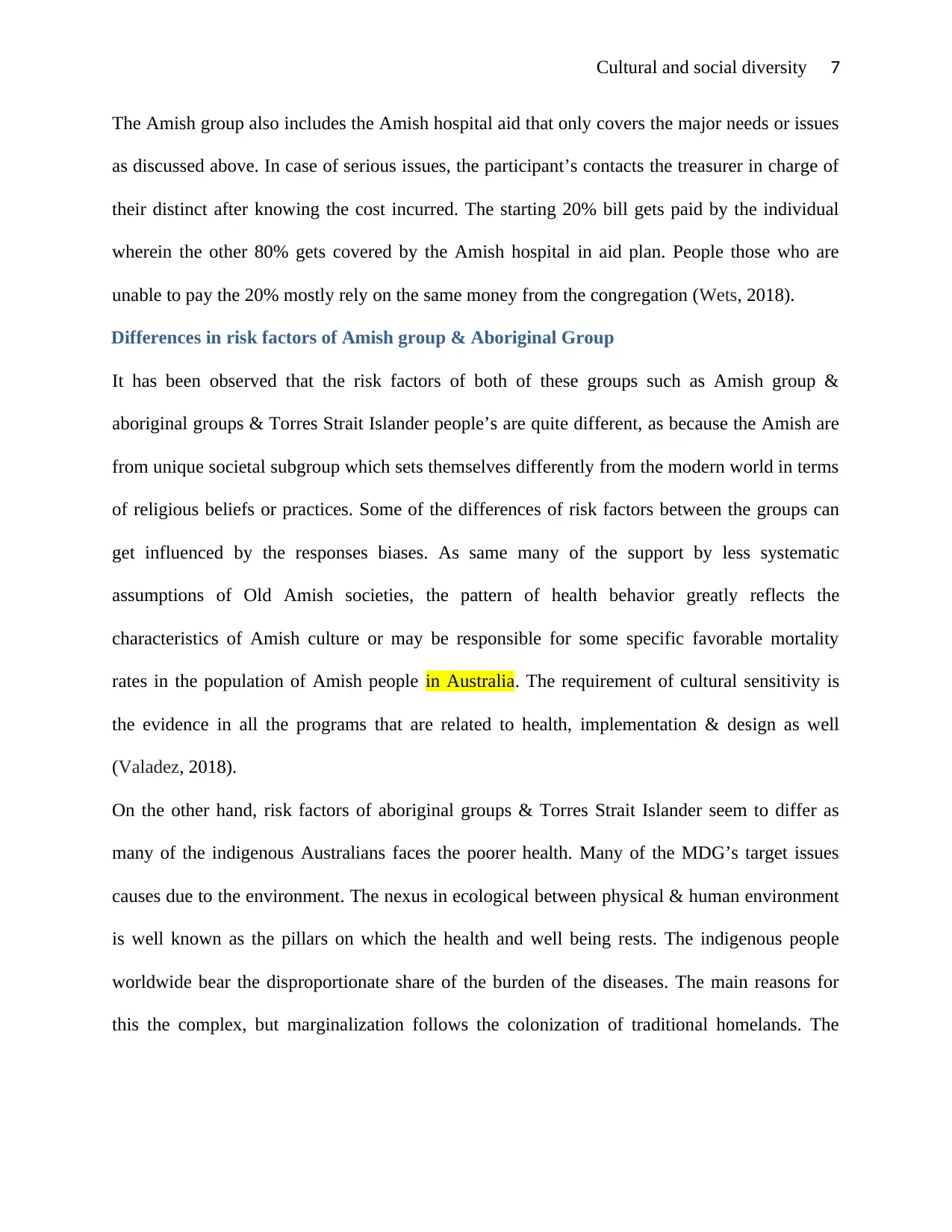
Cultural and social diversity 7
The Amish group also includes the Amish hospital aid that only covers the major needs or issues
as discussed above. In case of serious issues, the participant’s contacts the treasurer in charge of
their distinct after knowing the cost incurred. The starting 20% bill gets paid by the individual
wherein the other 80% gets covered by the Amish hospital in aid plan. People those who are
unable to pay the 20% mostly rely on the same money from the congregation (Wets, 2018).
Differences in risk factors of Amish group & Aboriginal Group
It has been observed that the risk factors of both of these groups such as Amish group &
aboriginal groups & Torres Strait Islander people’s are quite different, as because the Amish are
from unique societal subgroup which sets themselves differently from the modern world in terms
of religious beliefs or practices. Some of the differences of risk factors between the groups can
get influenced by the responses biases. As same many of the support by less systematic
assumptions of Old Amish societies, the pattern of health behavior greatly reflects the
characteristics of Amish culture or may be responsible for some specific favorable mortality
rates in the population of Amish people in Australia. The requirement of cultural sensitivity is
the evidence in all the programs that are related to health, implementation & design as well
(Valadez, 2018).
On the other hand, risk factors of aboriginal groups & Torres Strait Islander seem to differ as
many of the indigenous Australians faces the poorer health. Many of the MDG’s target issues
causes due to the environment. The nexus in ecological between physical & human environment
is well known as the pillars on which the health and well being rests. The indigenous people
worldwide bear the disproportionate share of the burden of the diseases. The main reasons for
this the complex, but marginalization follows the colonization of traditional homelands. The
The Amish group also includes the Amish hospital aid that only covers the major needs or issues
as discussed above. In case of serious issues, the participant’s contacts the treasurer in charge of
their distinct after knowing the cost incurred. The starting 20% bill gets paid by the individual
wherein the other 80% gets covered by the Amish hospital in aid plan. People those who are
unable to pay the 20% mostly rely on the same money from the congregation (Wets, 2018).
Differences in risk factors of Amish group & Aboriginal Group
It has been observed that the risk factors of both of these groups such as Amish group &
aboriginal groups & Torres Strait Islander people’s are quite different, as because the Amish are
from unique societal subgroup which sets themselves differently from the modern world in terms
of religious beliefs or practices. Some of the differences of risk factors between the groups can
get influenced by the responses biases. As same many of the support by less systematic
assumptions of Old Amish societies, the pattern of health behavior greatly reflects the
characteristics of Amish culture or may be responsible for some specific favorable mortality
rates in the population of Amish people in Australia. The requirement of cultural sensitivity is
the evidence in all the programs that are related to health, implementation & design as well
(Valadez, 2018).
On the other hand, risk factors of aboriginal groups & Torres Strait Islander seem to differ as
many of the indigenous Australians faces the poorer health. Many of the MDG’s target issues
causes due to the environment. The nexus in ecological between physical & human environment
is well known as the pillars on which the health and well being rests. The indigenous people
worldwide bear the disproportionate share of the burden of the diseases. The main reasons for
this the complex, but marginalization follows the colonization of traditional homelands. The
Paraphrase This Document
Need a fresh take? Get an instant paraphrase of this document with our AI Paraphraser
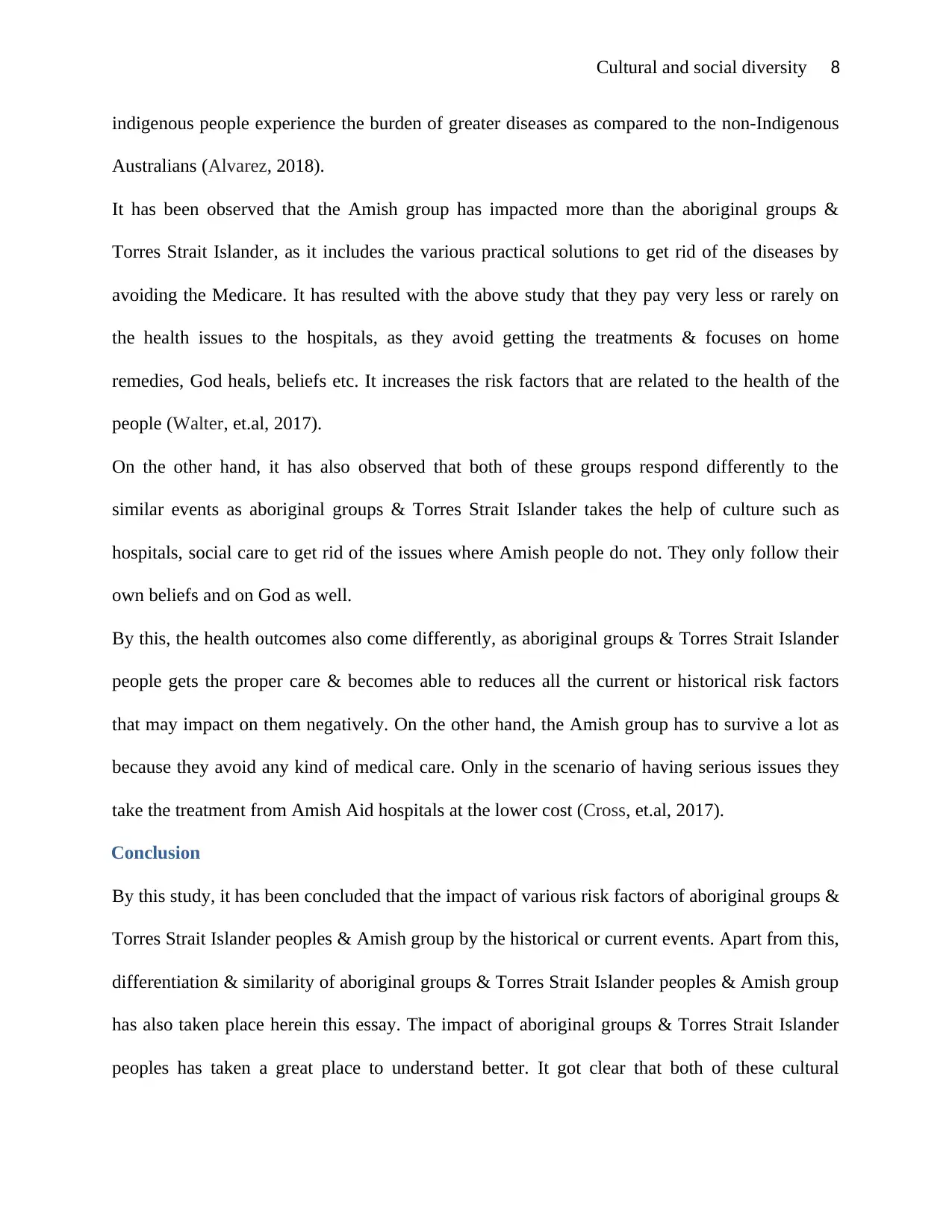
Cultural and social diversity 8
indigenous people experience the burden of greater diseases as compared to the non-Indigenous
Australians (Alvarez, 2018).
It has been observed that the Amish group has impacted more than the aboriginal groups &
Torres Strait Islander, as it includes the various practical solutions to get rid of the diseases by
avoiding the Medicare. It has resulted with the above study that they pay very less or rarely on
the health issues to the hospitals, as they avoid getting the treatments & focuses on home
remedies, God heals, beliefs etc. It increases the risk factors that are related to the health of the
people (Walter, et.al, 2017).
On the other hand, it has also observed that both of these groups respond differently to the
similar events as aboriginal groups & Torres Strait Islander takes the help of culture such as
hospitals, social care to get rid of the issues where Amish people do not. They only follow their
own beliefs and on God as well.
By this, the health outcomes also come differently, as aboriginal groups & Torres Strait Islander
people gets the proper care & becomes able to reduces all the current or historical risk factors
that may impact on them negatively. On the other hand, the Amish group has to survive a lot as
because they avoid any kind of medical care. Only in the scenario of having serious issues they
take the treatment from Amish Aid hospitals at the lower cost (Cross, et.al, 2017).
Conclusion
By this study, it has been concluded that the impact of various risk factors of aboriginal groups &
Torres Strait Islander peoples & Amish group by the historical or current events. Apart from this,
differentiation & similarity of aboriginal groups & Torres Strait Islander peoples & Amish group
has also taken place herein this essay. The impact of aboriginal groups & Torres Strait Islander
peoples has taken a great place to understand better. It got clear that both of these cultural
indigenous people experience the burden of greater diseases as compared to the non-Indigenous
Australians (Alvarez, 2018).
It has been observed that the Amish group has impacted more than the aboriginal groups &
Torres Strait Islander, as it includes the various practical solutions to get rid of the diseases by
avoiding the Medicare. It has resulted with the above study that they pay very less or rarely on
the health issues to the hospitals, as they avoid getting the treatments & focuses on home
remedies, God heals, beliefs etc. It increases the risk factors that are related to the health of the
people (Walter, et.al, 2017).
On the other hand, it has also observed that both of these groups respond differently to the
similar events as aboriginal groups & Torres Strait Islander takes the help of culture such as
hospitals, social care to get rid of the issues where Amish people do not. They only follow their
own beliefs and on God as well.
By this, the health outcomes also come differently, as aboriginal groups & Torres Strait Islander
people gets the proper care & becomes able to reduces all the current or historical risk factors
that may impact on them negatively. On the other hand, the Amish group has to survive a lot as
because they avoid any kind of medical care. Only in the scenario of having serious issues they
take the treatment from Amish Aid hospitals at the lower cost (Cross, et.al, 2017).
Conclusion
By this study, it has been concluded that the impact of various risk factors of aboriginal groups &
Torres Strait Islander peoples & Amish group by the historical or current events. Apart from this,
differentiation & similarity of aboriginal groups & Torres Strait Islander peoples & Amish group
has also taken place herein this essay. The impact of aboriginal groups & Torres Strait Islander
peoples has taken a great place to understand better. It got clear that both of these cultural
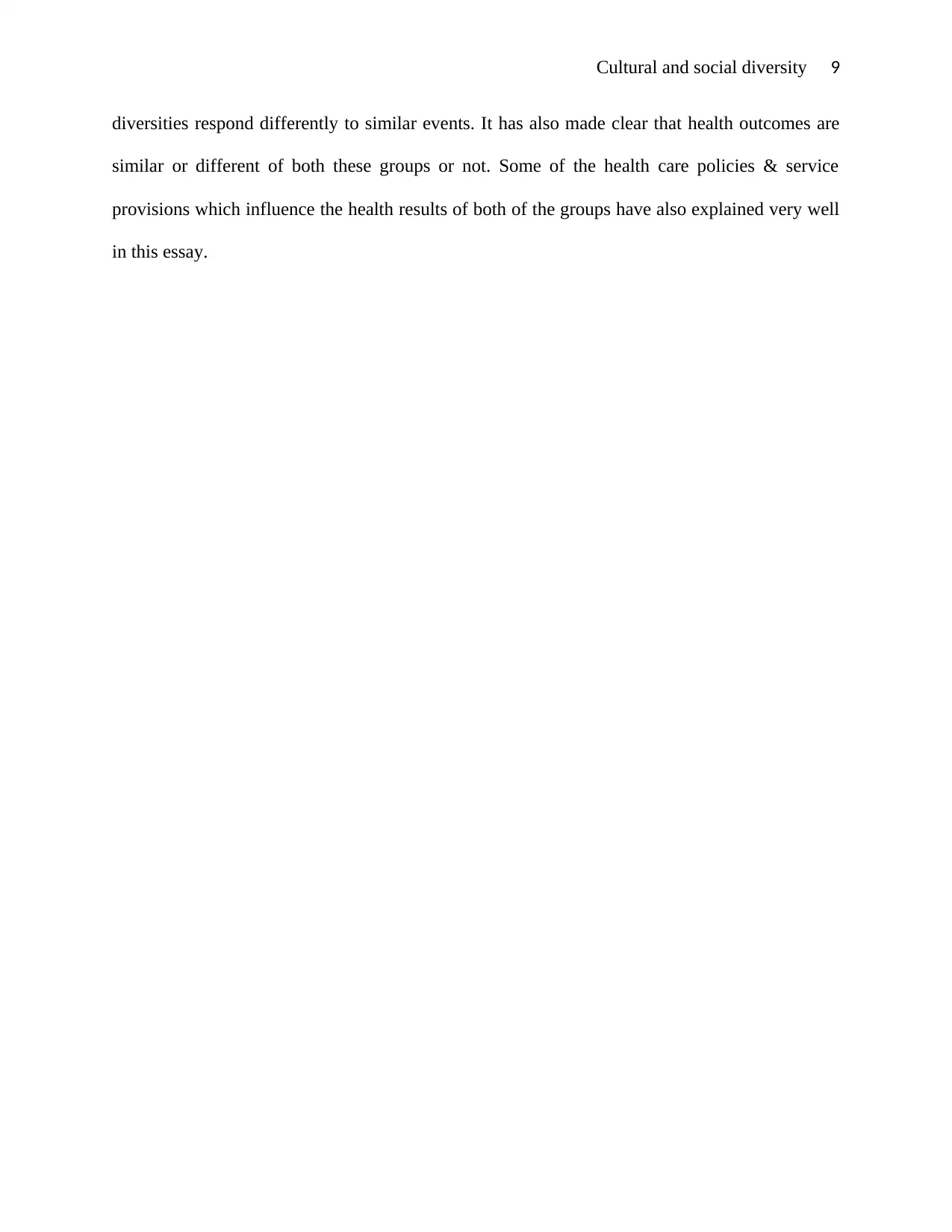
Cultural and social diversity 9
diversities respond differently to similar events. It has also made clear that health outcomes are
similar or different of both these groups or not. Some of the health care policies & service
provisions which influence the health results of both of the groups have also explained very well
in this essay.
diversities respond differently to similar events. It has also made clear that health outcomes are
similar or different of both these groups or not. Some of the health care policies & service
provisions which influence the health results of both of the groups have also explained very well
in this essay.
⊘ This is a preview!⊘
Do you want full access?
Subscribe today to unlock all pages.

Trusted by 1+ million students worldwide
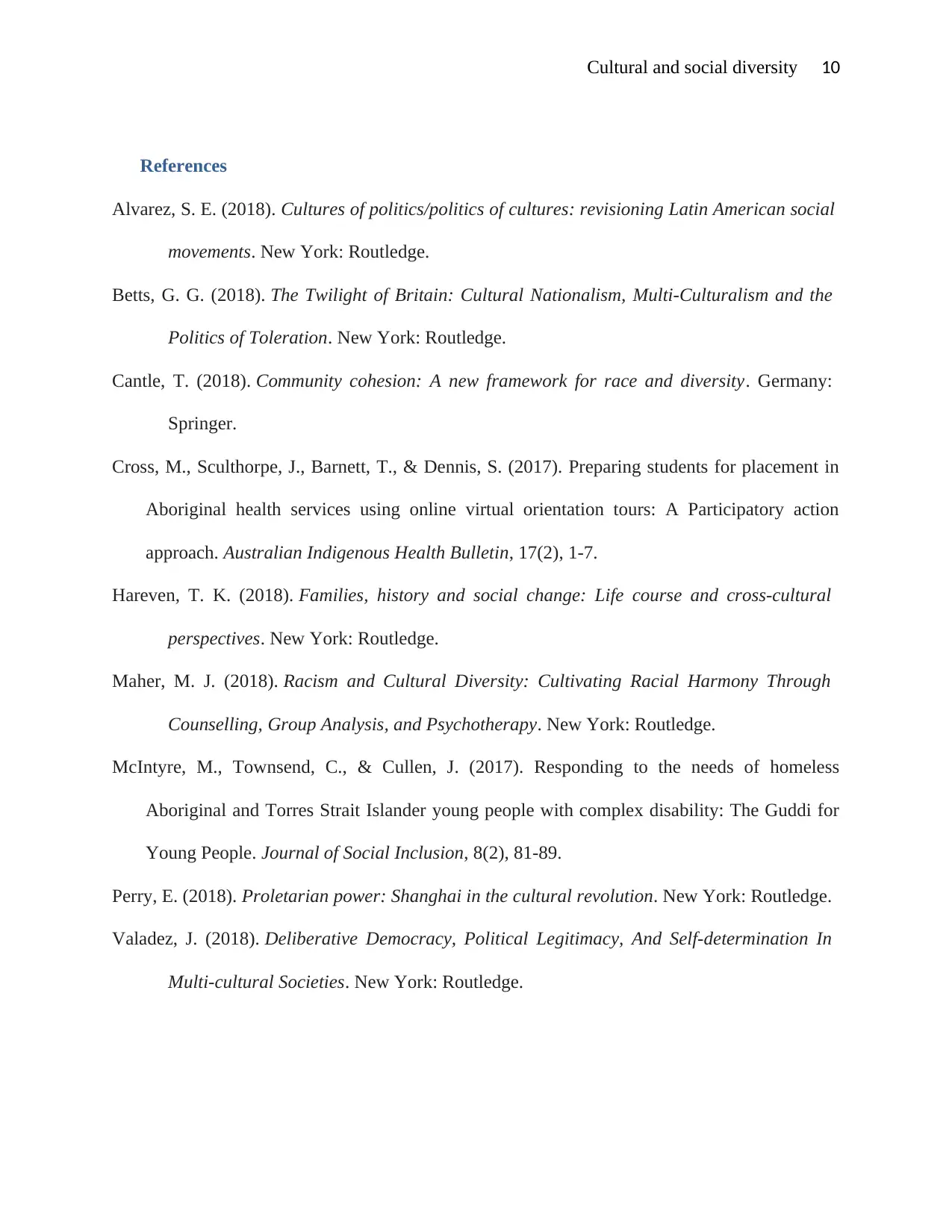
Cultural and social diversity 10
References
Alvarez, S. E. (2018). Cultures of politics/politics of cultures: revisioning Latin American social
movements. New York: Routledge.
Betts, G. G. (2018). The Twilight of Britain: Cultural Nationalism, Multi-Culturalism and the
Politics of Toleration. New York: Routledge.
Cantle, T. (2018). Community cohesion: A new framework for race and diversity. Germany:
Springer.
Cross, M., Sculthorpe, J., Barnett, T., & Dennis, S. (2017). Preparing students for placement in
Aboriginal health services using online virtual orientation tours: A Participatory action
approach. Australian Indigenous Health Bulletin, 17(2), 1-7.
Hareven, T. K. (2018). Families, history and social change: Life course and cross-cultural
perspectives. New York: Routledge.
Maher, M. J. (2018). Racism and Cultural Diversity: Cultivating Racial Harmony Through
Counselling, Group Analysis, and Psychotherapy. New York: Routledge.
McIntyre, M., Townsend, C., & Cullen, J. (2017). Responding to the needs of homeless
Aboriginal and Torres Strait Islander young people with complex disability: The Guddi for
Young People. Journal of Social Inclusion, 8(2), 81-89.
Perry, E. (2018). Proletarian power: Shanghai in the cultural revolution. New York: Routledge.
Valadez, J. (2018). Deliberative Democracy, Political Legitimacy, And Self-determination In
Multi-cultural Societies. New York: Routledge.
References
Alvarez, S. E. (2018). Cultures of politics/politics of cultures: revisioning Latin American social
movements. New York: Routledge.
Betts, G. G. (2018). The Twilight of Britain: Cultural Nationalism, Multi-Culturalism and the
Politics of Toleration. New York: Routledge.
Cantle, T. (2018). Community cohesion: A new framework for race and diversity. Germany:
Springer.
Cross, M., Sculthorpe, J., Barnett, T., & Dennis, S. (2017). Preparing students for placement in
Aboriginal health services using online virtual orientation tours: A Participatory action
approach. Australian Indigenous Health Bulletin, 17(2), 1-7.
Hareven, T. K. (2018). Families, history and social change: Life course and cross-cultural
perspectives. New York: Routledge.
Maher, M. J. (2018). Racism and Cultural Diversity: Cultivating Racial Harmony Through
Counselling, Group Analysis, and Psychotherapy. New York: Routledge.
McIntyre, M., Townsend, C., & Cullen, J. (2017). Responding to the needs of homeless
Aboriginal and Torres Strait Islander young people with complex disability: The Guddi for
Young People. Journal of Social Inclusion, 8(2), 81-89.
Perry, E. (2018). Proletarian power: Shanghai in the cultural revolution. New York: Routledge.
Valadez, J. (2018). Deliberative Democracy, Political Legitimacy, And Self-determination In
Multi-cultural Societies. New York: Routledge.
Paraphrase This Document
Need a fresh take? Get an instant paraphrase of this document with our AI Paraphraser
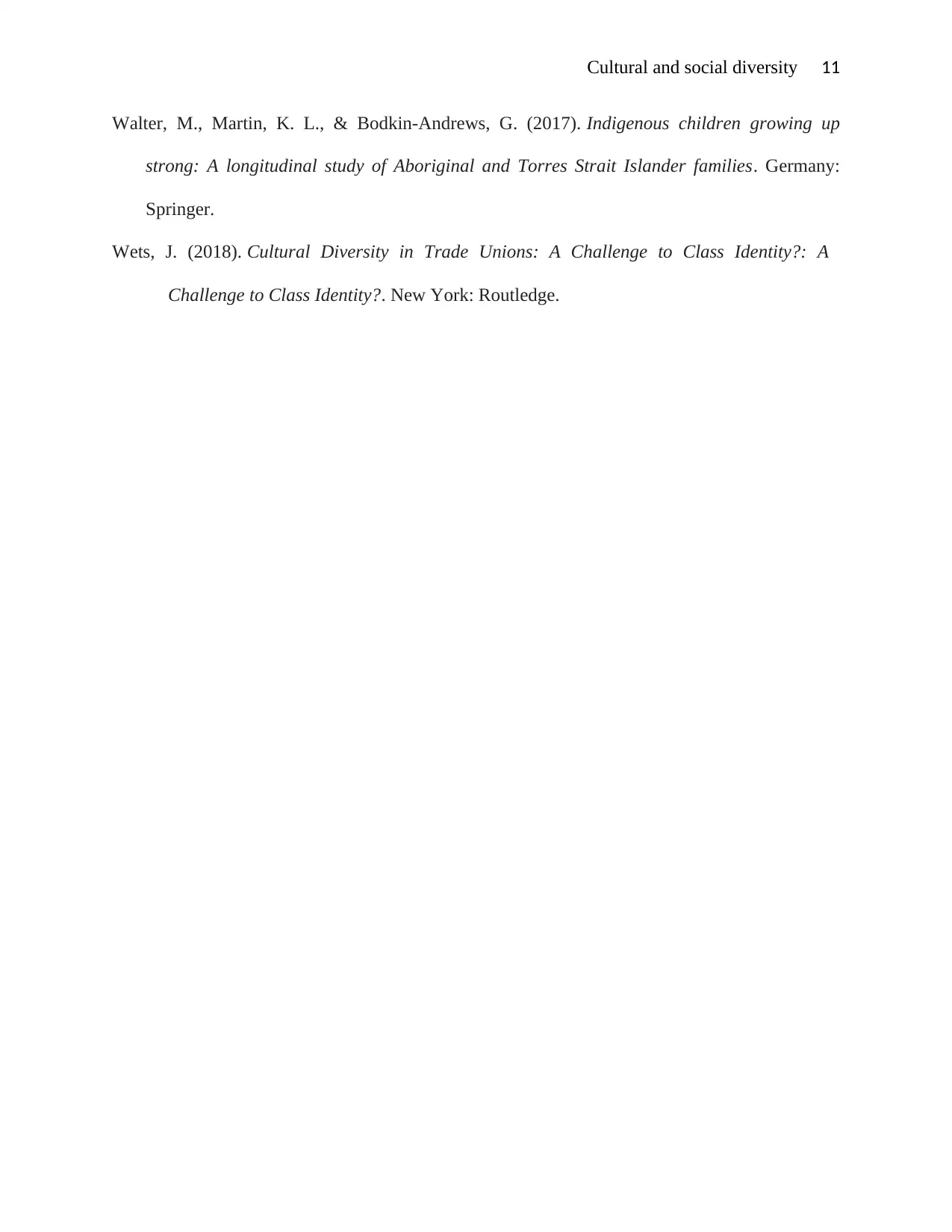
Cultural and social diversity 11
Walter, M., Martin, K. L., & Bodkin-Andrews, G. (2017). Indigenous children growing up
strong: A longitudinal study of Aboriginal and Torres Strait Islander families. Germany:
Springer.
Wets, J. (2018). Cultural Diversity in Trade Unions: A Challenge to Class Identity?: A
Challenge to Class Identity?. New York: Routledge.
Walter, M., Martin, K. L., & Bodkin-Andrews, G. (2017). Indigenous children growing up
strong: A longitudinal study of Aboriginal and Torres Strait Islander families. Germany:
Springer.
Wets, J. (2018). Cultural Diversity in Trade Unions: A Challenge to Class Identity?: A
Challenge to Class Identity?. New York: Routledge.
1 out of 11
Related Documents
Your All-in-One AI-Powered Toolkit for Academic Success.
+13062052269
info@desklib.com
Available 24*7 on WhatsApp / Email
![[object Object]](/_next/static/media/star-bottom.7253800d.svg)
Unlock your academic potential
Copyright © 2020–2025 A2Z Services. All Rights Reserved. Developed and managed by ZUCOL.




